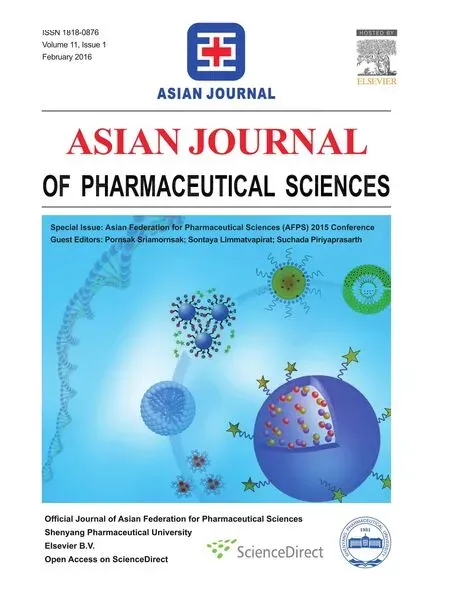Nanotechnology:Effective topical delivery systems
Tasana Pitaksuteepong
Department of Pharmaceutical Technology,Faculty of Pharmaceutical Sciences,Naresuan University, Phitsanulok 65000,Thailand
Nanotechnology:Effective topical delivery systems
Tasana Pitaksuteepong*
Department of Pharmaceutical Technology,Faculty of Pharmaceutical Sciences,Naresuan University, Phitsanulok 65000,Thailand
A R T I C L E I N F O
Article history:
Available online 23 November 2015
Nanotechnology
Topical
Polymeric nanoparticles
Micelles
Microemulsions
Lyotropic liquid crystal
Nanotechnology has received much interest nowadays.It is defned as techniques,methods or processes to fabricate nanoscale structures with size less than 100 nm.The delivery of a compound via skin offers many advantages including being pain-free,ease of administration,avoidance of hepatic frstpass metabolism and low cost.However,the major barrier of this route is the stratum corneum,which is the outermost layer of the epidermis.Thus effective nanodelivery systems are essential and no wonder why these systems reveal signifcant roles in delivery of cosmetics,drugs and biological products via topical routes these days.There are a variety of nanodelivery systems for topical route.However,this presentation covers polymeric nanoparticles and amphiphilicassociation structures,which are the systems of the author’s particular interest.
Polymeric nanoparticles:The polymeric nanoparticles are solid particles prepared using biodegradable and biocompatible polymers or monomers having size in the nanometer range. The preparation of the nanoparticles can be divided into two techniques:the dispersion of preformed polymers and the polymerization of monomers[1].Depending on the preparation techniques,templates as well as conditions used such as stirring speed,pH,ionic strength,type and concentration of surfactant/stabilizer and temperature etc.,the nanoparticles with desired properties can be prepared.The advantages of nanoparticles for topical delivery include:1) physically stable compared to liposomes;2)an encapsulated active compound can be stabilized;3)site-specifc targeting can be achieved and thus low dose of the active compound is needed;4)the release of the compound can be controlled and 5)their small size(<50 nm)enables them to penetrate through skin.
Amphiphilic-association structures:Amphiphilic-association structures including micelles,microemulsions,and lyotropic liquid crystals are formed by self-assembly of amphiphilic molecules.The formation of the surfactant aggregates with differentshapes can be determined by the critical packing parameter (CPP),which is defned in terms of area of hydrophilic head group per hydrophobic chain volume as following equation[2]:

where v is the volume of hydrocarbon chain,a0is the area of hydrophilic head group,and l is the hydrocarbon chain length of a surfactant.When CPP is less than 1,surfactant flm generally bends toward polar core.Oppositely,when it is more than 1,surfactant flm bends toward non-polar core. However,the lamellar structure is obtained when CPP is equal to 1.The advantages of amphiphilic-association structures are being thermodynamically stable,ease of preparation and low production costs.Interestingly these delivering systems can be incorporated in both hydrophilic and hydrophobic active compounds.Thus they are candidate systems for herbal extracts containing a mixture of complex compounds,which is known to be challenging to effciently formulate.
The discussion on how these systems can be tailor-made and their applications in various felds will be given in this talk.
Acknowledgements
The author would like to acknowledge all of the former and the present graduate students whose works were included in this presentation.
R E F E R E N C E S
[1]Rao JP,Geckeler KE.Polymer nanoparticles:preparation techniques and size-control parameters.Prog Polym Sci 2011;36(7):887–913.
[2]Israelachvili JN,Mitchell DJ,Ninham BW.Theory of selfassembly of hydrocarbon amphiphiles into micelles and bilayers.J Chem Soc Faraday Trans 2 Mol Chem Phys 1976;72:1525–1568.
*E-mail address:tasanap@nu.ac.th.
Peer review under responsibility of Shenyang Pharmaceutical University.
http://dx.doi.org/10.1016/j.ajps.2015.10.012
1818-0876/?2016 The Author.Production and hosting by Elsevier B.V.on behalf of Shenyang Pharmaceutical University.This is an open access article under the CC BY-NC-ND license(http://creativecommons.org/licenses/by-nc-nd/4.0/).
 Asian Journal of Pharmacentical Sciences2016年1期
Asian Journal of Pharmacentical Sciences2016年1期
- Asian Journal of Pharmacentical Sciences的其它文章
- Determination of the antidepressant effect of mirtazapine augmented with caffeine using Swiss-albino mice
- Photosafety testing of dermally-applied chemicals based on photochemical and cassette-dosing pharmacokinetic data
- Biopharmaceutics classifcation system(BCS)-based biowaiver for immediate release solid oral dosage forms of moxifoxacin hydrochloride (Moxifox GPO)manufactured by the Government Pharmaceutical Organization(GPO)
- Bioequivalence study of abacavir/lamivudine (600/300-mg)tablets in healthy Thai volunteers under fasting conditions
- Evaluation of cytotoxic and infammatory properties of clove oil microemulsion in mice
- Analytical method development of pregabalin and related substances in extended release tablets containing polyethylene oxide
